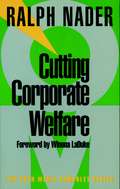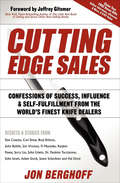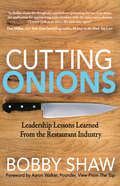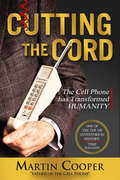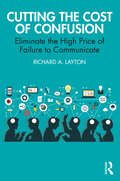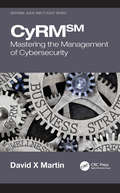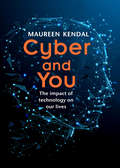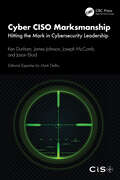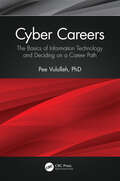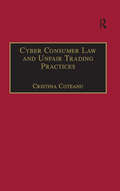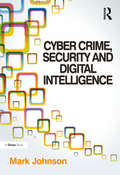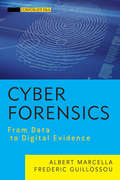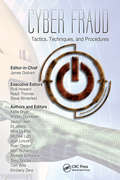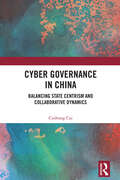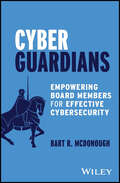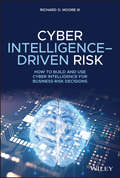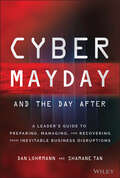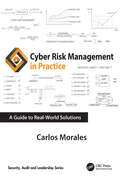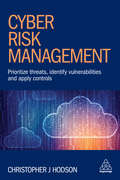- Table View
- List View
Cutter & Buck (B)
by William A. Sahlman Victoria W. WinstonAn abstract is not available for this product.
Cutter & Buck (B)
by William A. Sahlman Victoria W. WinstonAn abstract is not available for this product.
Cutting Corporate Welfare (Open Media Series)
by Winona Laduke Ralph NaderIn this groundbreaking pamphlet, based on testimony he delivered before Congress, Ralph Nader describes how corporations are picking our pockets, and what we can do to stop them.While the United States continues to experience unprecedented cuts in social service programs and millions of Americans go without health insurance, massive corporations continue to reap huge sums of taxpayer money through "corporate welfare"--corporate subsidies, bailouts, giveaways, and tax escapes. Cutting Corporate Welfare details numerous appalling examples of corporate welfare, including: the giveaway of the public airwaves, which by definition belong to the people, to private radio and television stations (including the latest $70 billion gift of the digital spectrum); taxpayer subsidies for giant defense corporation mergers and commercial weapons exports to governments overseas; and the practice of making patients pay twice for drugs--first, as taxpayers subsidize the drugs' development, and again, as patients, after the federal government gives monopolistic control over the chemical's manufacture to a price-gouging drug company. Cutting Corporate Welfare sounds a wake-up call for those concerned about how we are being pick-pocketed by big business, and what we can do to stop it.
Cutting Edge Sales: Confessions of Success, Influence & Self-Fulfillment from the World's Finest Knife Dealers
by Jon BerghoffA guide to successful selling from the professionals at Cutco Cutlery: &“Everybody needs the practical wisdom contained in Cutting Edge Sales&” (Brian Tracy). Since 1949, a growing culture of Cutco Cutlery salespeople has been quietly grooming our nation's youth to be the next generation of CEOs, philanthropists, and entrepreneurial success stories. Here, twelve former and three current Cutco Cutlery sales professionals—with over $300 million combined in Cutco Cutlery sales—have gathered together to collaborate and share their influence, secrets and real world wisdom with sales professionals, business owners, and entrepreneurs across the globe. As a true expression of their willingness to give back, each author involved in this project agreed to donate 100% of their royalties to the charity of their choosing. Your purchase of this book will help the authors in their quest to positively transform the world—and your execution of the Cutting Edge Sales lessons will positively transform you and your business.
Cutting Onions: Leadership Lessons Learned From the Restaurant Industry
by Bobby ShawCutting Onions shares restaurant executive Bobby Shaw’s journey from starting out as an hourly employee at McDonald’s to becoming a senior executive in the restaurant industry, what he learned along the way, and how it changed the course of his life and countless others. The importance of culture is referenced by many leaders trying to build an organization, but it isn’t always reflected in the day-to-day actions of that organization. This leadership guide chronicles the journey of one leader through one of the most challenging and rewarding industries, eventually inspiring hundreds of other leaders along the way to do more than they ever thought possible. Bobby dives into the challenges he overcame and how, along the way, he learned the importance of building a strong culture in which people wanted more for each other than they wanted for themselves. Cutting Onions tells the story of a restaurant that figured it out and tied the results they achieved right back to their culture, represented by the simple, everyday things that, as all leaders learn, are the most important.
Cutting the Cord: The Cell Phone has Transformed Humanity
by Martin CooperOne of Time Magazine&’s Top 100 Inventors in History shares an insider&’s story of the cellphone, how it changed the world—and a view of where it&’s headed. While at Motorola in the 1970s, wireless communications pioneer Martin Cooper invented the first handheld mobile phone. But the cellphone as we know it today almost didn&’t happen. Now, in Cutting the Cord, Cooper takes readers inside the stunning breakthroughs, devastating failures, and political battles in the quest to revolutionize—and control—how people communicate. It&’s a dramatic tale involving brilliant engineers, government regulators, lobbyists, police, quartz crystals, and a horse. Industry skirmishes sparked a political war in Washington to prevent a monopolistic company from dominating telecommunications. The drama culminated in the first-ever public call made on a handheld, portable telephone—by Cooper himself. The story of the cell phone has much to teach about innovation, strategy, and management. But the story of wireless communications is far from finished. This book also relates Cooper&’s vision of the future. From the way we work and the way children learn to the ways we approach medicine and healthcare, advances in the cellphone will continue to reshape our world for the better.
Cutting the Cost of Confusion: Eliminate the High Price of Failure to Communicate
by Richard A. LaytonConfusion is more than just another daily inconvenience, though its impacts are often hidden in metrics such as market share, productivity, and ROI. This book shows how to identify and eliminate the Cost of Confusion in workplaces, marketplaces, and communities. Cutting that cost demands the ability to distill, integrate, and synthesize ever more complex information from a broad range of perspectives and disciplines. Any gaps in understanding can and do negatively impact performance. Based on Richard Layton’s 20 years of experience helping organizations to be heard and understood, this book offers a powerful universal lens to view the costly impacts of confusion, and provides a framework to identify and manage the risk of failure to communicate with a range of stakeholders and audiences – and save millions of dollars in the process. Decision-makers, practitioners, and students in marketing and advertising, organizational development, knowledge management, information technology, project management, and other fields will appreciate this unique set of insights and tools they can employ to great effect within their companies, organizations, and public institutions.
Cutting the Cost of Confusion: Eliminate the High Price of Failure to Communicate
by Richard LaytonConfusion is more than just another daily inconvenience, though its impacts are often hidden in metrics such as market share, productivity, and ROI. This book shows how to identify and eliminate the Cost of Confusion in workplaces, marketplaces, and communities.Cutting that cost demands the ability to distill, integrate, and synthesize ever more complex information from a broad range of perspectives and disciplines. Any gaps in understanding can and do negatively impact performance. Based on Richard Layton’s 20 years of experience helping organizations to be heard and understood, this book offers a powerful universal lens to view the costly impacts of confusion, and provides a framework to identify and manage the risk of failure to communicate with a range of stakeholders and audiences – and save millions of dollars in the process. Decision-makers, practitioners, and students in marketing and advertising, organizational development, knowledge management, information technology, project management, and other fields will appreciate this unique set of insights and tools they can employ to great effect within their companies, organizations, and public institutions.
Cutting the Distance: Benefits and Tensions from the Recent Active Engagement of China, Japan, and Korea in Latin America (SpringerBriefs in Economics)
by Nobuaki Hamaguchi Jie Guo Chong-Sup KimThis book represents a valuable contribution to the study of Asia–Latin America relations from the unprecedented collaboration of leading Latin American specialists of China, Japan, and Korea, representing views from their respective countries. The academic literature on this topic remains quite limited in spite of rapid expansion of the interregional trade and investment and active engagements to institutionalize relationships in recent years. Especially, the views from Asian academic researchers have not been expressed often. This book reveals why the partnership between the two geographically distant regions has gained more importance recently. The authors also discuss some tensions arising from the intensifying relationship, including the concentration in a few commodities of Latin American exports and the competition of Latin American industry with Asian exports, as well as geopolitical problems.
Cuéntele su Historia al Mundo y Véndala por Millones
by Kenneth Atchity Lisa CerasoliCuéntele su Historia al Mundo y Véndala por Millones, es un libro infaltable tanto para escritores como para guionistas. Posee todo aquello que no le dicen a uno mientras cursa una carrera relacionada con la creación literaria. Pero no solamente son los meros datos de usos y costumbres de los mercados editoriales, también de los nuevos mercados y las posibilidades de una edición electrónica sin pasar por las casas editoriales. ¡Ni hablar de hacer que su historia esté "en forma" para la soñada posibilidad de que su libro se convierta en una película! Este libro lo ayudará efictivamente a contar su historia al mundo, y lo ayudará a venderla por millones!!!
CyRM℠: Mastering the Management of Cybersecurity (Internal Audit and IT Audit)
by David MartinIs your enterprise’s strategy for cybersecurity just crossing its fingers and hoping nothing bad ever happens? If so…you’re not alone. Getting cybersecurity right is all too often an afterthought for Fortune 500 firms, bolted on and hopefully creating a secure environment. We all know this approach doesn’t work, but what should a smart enterprise do to stay safe? Today, cybersecurity is no longer just a tech issue. In reality, it never was. It’s a management issue, a leadership issue, a strategy issue: It’s a "must have right"…a survival issue. Business leaders and IT managers alike need a new paradigm to work together and succeed. After years of distinguished work as a corporate executive, board member, author, consultant, and expert witness in the field of risk management and cybersecurity, David X Martin is THE pioneering thought leader in the new field of CyRMSM. Martin has created an entirely new paradigm that approaches security as a business problem and aligns it with business needs. He is the go-to guy on this vitally important issue. In this new book, Martin shares his experience and expertise to help you navigate today’s dangerous cybersecurity terrain, and take proactive steps to prepare your company—and yourself —to survive, thrive, and keep your data (and your reputation) secure.
Cyber & You: Book 2 (Smart Skills)
by Maureen KendalCyber & You is a fascinating look at our lives today and what our lives will be like in the future. The focus is on the development of human interaction, how humans are impacted by technology, and the affect cyberspace interactions have on the minds of individuals and on society as a whole.The book addresses areas such as: access and modes of communication, Virtual Community, Virtual self, Economic Divide, and Block Chains. It also covers:Morals and Ethics: Behavioural development, personal characteristics, and redefining relationshipsThe Future: Consumer landscape, Technology and the workforce, Cyber learning and education and Lifestyle disruptions.
Cyber Breach at Target
by Lynn S. Paine Suraj Srinivasan Neeraj GoyalIn November and December of 2013, Target Corporation suffered one of the largest cyber breaches till date. The breach that occurred during the busy holiday shopping season resulted in personal and credit card information of about 110 million Target customers to be compromised. The case describes the details of the breach, circumstances that lead to it, consequences for customers and for Target, and the company's response. The case then discusses the role of management and the board of directors in cyber security at Target. Target's board of directors was subject to intense criticism by shareholders and governance experts such as the leading proxy advisor Institutional Shareholder Services (ISS). The case discusses the critique and defense of the board's role. The case is designed to allow for a discussion of the causes and consequences of the cyber breach and accountability of directors in cyber security.
Cyber CISO Marksmanship: Hitting the Mark in Cybersecurity Leadership
by James Johnson Ken Dunham Joseph McComb Jason ElrodCyber CISO Marksmanship is the only book of its kind authored by multiple highly experienced individuals to collectively bring together the "best of the best" on what works and what doesn’t, as a CISO, in a unique storytelling format. This book is designed for a Chief Information Security Officer (CISO) or an individual seeking this role and also has value to other types of cyber leaders. Knowledge and understanding of traditional books can only get you so far – Cyber CISO Marksmanship has powerful perspectives, real-world accounts, and insights you won’t find anywhere else!Key features included with Cyber CISO Marksmanship: Over a century of CISO experience is represented by the authors of this book Unique storytelling format based upon real-world accounts from leading CISOs Sharpshooter perspectives from multiple CISOs for each story Bottom Line Up Front (BLUF) for quick reference on outcomes for each story Sharpshooter icon for what works Misfire icon for pitfalls to avoid All book owners are invited to participate in online content at CyberCISOMarksmanship.com and face-to-face events Book owners who are CISOs qualify to join, for free, a private CISO online community (by CISOs for CISOs) While this book is written for CISOs or those desiring to be in that role soon, it is also helpful to other cyber leaders.
Cyber Careers: The Basics of Information Technology and Deciding on a Career Path
by Pee VulullehThe approach taken in this book emphasizes the basics of information technology and helps students decide whether to pursue an information technology career. Most students fail to pursue an IT career because of their limited knowledge (sometimes no knowledge) about the area. Similarly, most students pursuing a career in IT do not research the field before their pursuit. This book is purposely designed for students in this category. The book may be offered as a required text for an elective or core course to all bachelor's degree students regardless of specialization. Compared to other textbooks, this text guides students pursuing or wanting to pursue an IT degree/career. Most students often begin their study of IT without knowing the outside and inside of the area. Most of these students can change their minds to pursue a different career path after spending several semesters of studies, a waste of their time. If students are taught from the onset about what an IT career entails and what it takes to become successful, it will significantly help students and not waste their time. This book addresses the issue.
Cyber Consumer Law and Unfair Trading Practices (Markets and the Law)
by Cristina CoteanuOf great interest to practitioners, policymakers and academics - as well as to consumers and traders in general - this timely work addresses all important legal and practical issues that arise in connection with online trading. This important work outlines the existing legislation and legal jurisprudence in the EU and the US and exposes the potential for unfair commercial practices to arise from online contracts, electronic agents, disclosure of information, online advertising and online dispute resolution in cross-border transactions. The continuing prevalence of unfair commercial practices will ensure this book remains in great demand.
Cyber Crime, Security and Digital Intelligence: Vulnerabilities Risks Threat Actors And Controls In The Information Age
by Mark JohnsonToday's digital economy is uniquely dependent on the Internet, yet few users or decision makers have more than a rudimentary understanding of the myriad of online risks that threaten us. Cyber crime is one of the main threats to the integrity and availability of data and systems. From insiders to complex external attacks and industrial worms, modern business faces unprecedented challenges; and while cyber security and digital intelligence are the necessary responses to this challenge, they are understood by only a tiny minority. In his second book on high-tech risks, Mark Johnson goes far beyond enumerating past cases and summarising legal or regulatory requirements. He describes in plain, non-technical language how cyber crime has evolved and the nature of the very latest threats. He confronts issues that are not addressed by codified rules and practice guidelines, supporting this with over 30 valuable illustrations and tables. Written for the non-technical layman and the high tech risk manager alike, the book also explores countermeasures, penetration testing, best practice principles, cyber conflict and future challenges. A discussion of Web 2.0 risks delves into the very real questions facing policy makers, along with the pros and cons of open source data. In a chapter on Digital Intelligence readers are provided with an exhaustive guide to practical, effective and ethical online investigations. Cyber Crime, Security and Digital Intelligence is an important work of great relevance in today's interconnected world and one that nobody with an interest in either risk or technology should be without.
Cyber Forensics
by Frederic Guillossou Albert J. Marcella Jr.An explanation of the basic principles of dataThis book explains the basic principles of data as building blocks of electronic evidential matter, which are used in a cyber forensics investigations. The entire text is written with no reference to a particular operation system or environment, thus it is applicable to all work environments, cyber investigation scenarios, and technologies. The text is written in a step-by-step manner, beginning with the elementary building blocks of data progressing upwards to the representation and storage of information. It inlcudes practical examples and illustrations throughout to guide the reader.
Cyber Fraud: Tactics, Techniques and Procedures
by Rick HowardWith millions lost each year, cyber crime has evolved from a minor nuisance to a major concern involving well-organized actors and highly sophisticated organizations. Arguably one of the most important challenges of the 21st century, with millions lost each year, cyber crime has evolved from a minor nuisance to a major concern involving well-organized actors and highly sophisticated organizations. This volume explores the state of threats present in the cyber fraud underground. It discusses phishing/pharming, trojans/toolkits, direct threats, and pump-and-dump scams. By examining the operations of the cyber criminal, the book provides perspective into the general incentives, risks, and behavioral patterns of the fraudsters. Armed with this information, organizations and individuals are better able to develop countermeasures and crafting tactics to disrupt the fraud underground and secure their systems.
Cyber Governance in China: Balancing State Centrism and Collaborative Dynamics
by Cuihong CaiThis book conducts an in-depth investigation into cyber governance in China through Chinese decision-making processes, policy formulation, and international presence, exploring how China navigates governance imperatives while fostering digital innovation in an increasingly interconnected world.The book looks at the governance paradigm of cyberspace in China. It examines the concepts, mechanisms, and practices predominantly spearheaded at the national level by the Chinese government, and the extensive participation of non-governmental entities. It unravels China’s approach to cyber governance, why it diverges from Western approaches, and the causal mechanisms behind these phenomena through empirical research. The book also analyzes the strengths, deficiencies, and consequential impacts of China's cyber governance policies, utilizing social science research methodologies.This will be a book of interest to scholars in international relations, Internet governance, and China studies.
Cyber Guardians: Empowering Board Members for Effective Cybersecurity
by Bart R. McDonoughA comprehensive overview for directors aiming to meet their cybersecurity responsibilities In Cyber Guardians: Empowering Board Members for Effective Cybersecurity, veteran cybersecurity advisor Bart McDonough delivers a comprehensive and hands-on roadmap to effective cybersecurity oversight for directors and board members at organizations of all sizes. The author includes real-world case studies, examples, frameworks, and blueprints that address relevant cybersecurity risks, including the industrialized ransomware attacks so commonly found in today’s headlines. In the book, you’ll explore the modern cybersecurity landscape, legal and regulatory requirements, risk management and assessment techniques, and the specific role played by board members in developing and promoting a culture of cybersecurity. You’ll also find: Examples of cases in which board members failed to adhere to regulatory and legal requirements to notify the victims of data breaches about a cybersecurity incident and the consequences they faced as a result Specific and actional cybersecurity implementation strategies written for readers without a technical background What to do to prevent a cybersecurity incident, as well as how to respond should one occur in your organizationA practical and accessible resource for board members at firms of all shapes and sizes, Cyber Guardians is relevant across industries and sectors and a must-read guide for anyone with a stake in robust organizational cybersecurity.
Cyber Intelligence-Driven Risk: How to Build and Use Cyber Intelligence for Business Risk Decisions
by Richard O. Moore IIITurn cyber intelligence into meaningful business decisions and reduce losses from cyber events Cyber Intelligence-Driven Risk provides a solution to one of the most pressing issues that executives and risk managers face: How can we weave information security into our business decisions to minimize overall business risk? In today's complex digital landscape, business decisions and cyber event responses have implications for information security that high-level actors may be unable to foresee. What we need is a cybersecurity command center capable of delivering, not just data, but concise, meaningful interpretations that allow us to make informed decisions. Building, buying, or outsourcing a CI-DR™ program is the answer. In his work with executives at leading financial organizations and with the U.S. military, author Richard O. Moore III has tested and proven this next-level approach to Intelligence and Risk. This book is a guide to: Building, buying, or outsourcing a cyber intelligence–driven risk program Understanding the functional capabilities needed to sustain the program Using cyber intelligence to support Enterprise Risk Management Reducing loss from cyber events by building new organizational capacities Supporting mergers and acquisitions with predictive analytics Each function of a well-designed cyber intelligence-driven risk program can support informed business decisions in the era of increased complexity and emergent cyber threats.
Cyber Mayday and the Day After: A Leader's Guide to Preparing, Managing, and Recovering from Inevitable Business Disruptions
by Daniel Lohrmann Shamane TanSuccessfully lead your company through the worst crises with this first-hand look at emergency leadership Cyber security failures made for splashy headlines in recent years, giving us some of the most spectacular stories of the year. From the Solar Winds hack to the Colonial Pipeline ransomware event, these incidents highlighted the centrality of competent crisis leadership. Cyber Mayday and the Day After offers readers a roadmap to leading organizations through dramatic emergencies by mining the wisdom of C-level executives from around the globe. It’s loaded with interviews with managers and leaders who've been through the crucible and survived to tell the tale. From former FBI agents to Chief Information Security Officers, these leaders led their companies and agencies through the worst of times and share their hands-on wisdom. In this book, you’ll find out: What leaders wish they'd known before an emergency and how they've created a crisis game plan for future situations How executive-level media responses can maintain – or shatter – consumer and public trust in your firm How to use communication, coordination, teamwork, and partnerships with vendors and law enforcement to implement your crisis response Cyber Mayday and the Day After is a must-read experience that offers managers, executives, and other current or aspiring leaders a first-hand look at how to lead others through rapidly evolving crises.
Cyber Risk Management in Practice: A Guide to Real-World Solutions (Security, Audit and Leadership Series)
by Carlos MoralesCyber Risk Management in Practice: A Guide to Real-World Solutions is your companion in the ever-changing landscape of cybersecurity. Whether you're expanding your knowledge or looking to sharpen your existing skills, this book demystifies the complexities of cyber risk management, offering clear, actionable strategies to enhance your organization's security posture. With a focus on real-world solutions, this guide balances practical application with foundational knowledge.Key Features: Foundational Insights: Explore fundamental concepts, frameworks, and required skills that form the backbone of a strong and pragmatic cyber risk management program tailored to your organization’s unique needs. It covers everything from basic principles and threat modeling to developing a security-first culture that drives change within your organization. You’ll also learn how to align cybersecurity practices with business objectives to ensure a solid approach to risk management. Practical Application: Follow a hands-on step-by-step implementation guide through the complete cyber risk management cycle, from business context analysis to developing and implementing effective treatment strategies. This book includes templates, checklists, and practical advice to execute your cyber risk management implementation, making complex processes manageable and straightforward. Real-world scenarios illustrate common pitfalls and effective solutions. Advanced Strategies: Go beyond the basics to achieve cyber resilience. Explore topics like third-party risk management, integrating cybersecurity with business continuity, and managing the risks of emerging technologies like AI and quantum computing. Learn how to build a proactive defense strategy that evolves with emerging threats and keeps your organization secure. “Cyber Risk Management in Practice: A Guide to Real-World Solutions by Carlos Morales serves as a beacon for professionals involved not only in IT or cybersecurity but across executive and operational roles within organizations. This book is an invaluable resource that I highly recommend for its practical insights and clear guidance” – José Antonio Fernández Carbajal. Executive Chairman and CEO of FEMSA
Cyber Risk Management: Prioritize Threats, Identify Vulnerabilities and Apply Controls
by Christopher HodsonMost organizations are undergoing a digital transformation of some sort and are looking to embrace innovative technology, but new ways of doing business inevitably lead to new threats which can cause irreparable financial, operational and reputational damage. In an increasingly punitive regulatory climate, organizations are also under pressure to be more accountable and compliant. Cyber Risk Management clearly explains the importance of implementing a cyber security strategy and provides practical guidance for those responsible for managing threat events, vulnerabilities and controls, including malware, data leakage, insider threat and Denial-of-Service. Examples and use cases including Yahoo, Facebook and TalkTalk, add context throughout and emphasize the importance of communicating security and risk effectively, while implementation review checklists bring together key points at the end of each chapter. Cyber Risk Management analyzes the innate human factors around risk and how they affect cyber awareness and employee training, along with the need to assess the risks posed by third parties. Including an introduction to threat modelling, this book presents a data-centric approach to cyber risk management based on business impact assessments, data classification, data flow modelling and assessing return on investment. It covers pressing developments in artificial intelligence, machine learning, big data and cloud mobility, and includes advice on responding to risks which are applicable for the environment and not just based on media sensationalism.

